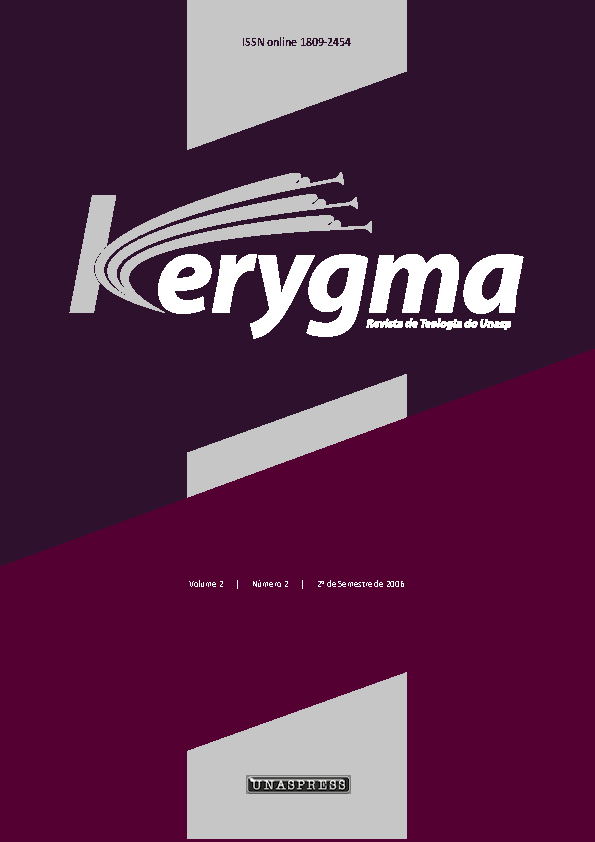Abstract
The objective of this research was to verify if the weekly worship promoted for the Adventist youth is reaching the goals idealized by the Seventh-day Adventist Church. Young adventists between ages 16 and 30 were interviewed. They belonged to three churches located in the cities of Piracicaba and Limeira, in the State of São Paulo, Brazil. The conclusion reached is that it exists a noticeable distance between the goals posited by the philosophy of the Adventist Youth Ministry, i.e. that of “salvation and ministry”, and the actual practice that takes place in programs that target the young people. It seems that, in the quest to attract young people to church, local youth leaders have opted for programs that emphasize in advantage entertainment.References
Allen, Malcolm J., O desafio do ministério jovem, 1ª ed. (Artur Nogueira, SP: Gráfica da União Central Brasileira, 1999).
________Conduccion divina o presion mundana? – El ministério joven em la Iglesia Adventista. (Buenos Aires, Argentina: Asociacion Casa Editora Sudamericana, 1995).
Enciclopédia J.A., (Brasília, D.F.: Departamento JA da Divisão Sul-Americana da IASD, 2000).
Entrevistas com os Jovens. (IASD Central, Limeira, 2005).
Entrevistas com os Jovens. (IASD Gustavo Piccinine, Limeira, 2005).
Entrevistas com os Jovens. (IASD Central, Piracicaba, 2005).
Manual da Igreja, (Santo André, SP: Casa Publicadora Brasileira, 1970).
Manual do Ministério Jovem, 1ª ed. (Brasília D.F., Divisão Sul – Americana da IASD, 1992).
Marski, Artur Elias. Análise do encontro semanal dos jovens adventistas nas igrejas da União Sul-Brasileira da IASD e uma proposta alternativa do seu conteúdo programático, 1ª ed. (Engenheiro Coelho - SP: SALT, 1984).
Novaes, Allan. Breve análise das reuniões dos jovens da Igreja Adventista do Sétimo Dia. (Engenheiro Coelho-SP: Revista Eletrônica Kerigma, www.unasp.edu/kerigma, 2005).
Timm, Alberto. “Podemos ainda ser considerados o povo da Bíblia?”: Revista Adventista, junho. (Tatuí, SP: Casa Publicadora Brasileira, 2001).
White, Ellen G. Educação, 5ª ed. (Santo André - SP: Casa Publicadora Brasileira, 1977).
Authors who publish on Kerygma must agree to the following terms:
- Once accepted for publication, the copyright of articles is automatically transferred to Kerygma.
- All material used in the text that is copyrighted by third parties must be duly referenced.
- Authors must also retain the reproduction rights of images and tables in their material, if necessary.
- The authors guarantee that the submitted text is entirely their authorship and has not been submitted and/or published elsewhere.
- The opinions, ideas and concepts expressed in the texts are the sole responsibility of their authors and do not necessarily represent the opinion of Kerygma;
- The editors reserve the right to make textual adjustments and adapt to the publication's norms.
- Authors retain copyright and grant the journal the right of first publication, with the work simultaneously licensed under Creative Commons Attribution-NonCommercial 4.0 International, which allows sharing of the work with acknowledgment of authorship and initial publication in this journal. This license allows others to remix, adapt, and build upon your work non-commercially, as long as they give proper credit to you and their new works are not used for commercial purposes. However, users are not required to license those derivative works under the same terms.
- The authors agree with the free reproduction of their material by Kerygma, which may adapt, modify, condense, summarize, reduce, compile, expand, alter, mix with other content, include images, graphics, digital objects, infographics and hyperlinks, illustrate, diagram, divide, update, translate and carry out any other transformations, requiring the participation or express authorization of the authors.
- The authors agree that Kerygma can distribute the articles through cable, fiber optics, satellite, airwaves or any other system that allows access to the user at a specific time and place, either by free channels or by systems that import payment. Kerygma may also include work in a physical or virtual database, archiving in printed format, storing on a computer, in a cloud system, microfilming and other current forms of archiving or that may still be developed, with or without profit.
- Authors are permitted to enter into separate, additional agreements for the non-exclusive distribution of the published version of the work in this journal (e.g., publishing it in an institutional repository or as a book chapter), with acknowledgment in the new publication of its initial publication in this journal.
- Kerygma owns the rights to all works published by it. The full reproduction of these texts in other publications, for any other purpose, by any means, requires written authorization from the publisher. The same goes for partial reproductions, such as summary, abstract, portions with more than 500 words of the text, tables, figures, illustrations, etc.
- Authors are granted permission and encouraged to publish and distribute their work online (e.g., in institutional repositories or on their personal websites) at any point before or during the editorial process. This is because it can lead to productive alterations and increase the impact and citation of the published work. (See "The effect of open access and downloads ('hits') on citation impact: a bibliography of studies.")

